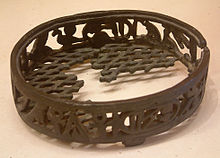Meryibre Khety
| Meryibre Khety | ||||||||||||||||||||||||||||||||||||||||||||||||||||||||||||||||||||||||||||||||||||||||||||||||||||||||||||||
|---|---|---|---|---|---|---|---|---|---|---|---|---|---|---|---|---|---|---|---|---|---|---|---|---|---|---|---|---|---|---|---|---|---|---|---|---|---|---|---|---|---|---|---|---|---|---|---|---|---|---|---|---|---|---|---|---|---|---|---|---|---|---|---|---|---|---|---|---|---|---|---|---|---|---|---|---|---|---|---|---|---|---|---|---|---|---|---|---|---|---|---|---|---|---|---|---|---|---|---|---|---|---|---|---|---|---|---|---|---|---|
| Meriibre, Meribre and Kheti, Akhtoy, Achthoes; Merybtawy, Meribtawy | ||||||||||||||||||||||||||||||||||||||||||||||||||||||||||||||||||||||||||||||||||||||||||||||||||||||||||||||
 Copper container with Meryibre Khety's royal titulary. Paris, Louvre. | ||||||||||||||||||||||||||||||||||||||||||||||||||||||||||||||||||||||||||||||||||||||||||||||||||||||||||||||
| Pharaoh | ||||||||||||||||||||||||||||||||||||||||||||||||||||||||||||||||||||||||||||||||||||||||||||||||||||||||||||||
| Reign | c. 2160 BCE –? | |||||||||||||||||||||||||||||||||||||||||||||||||||||||||||||||||||||||||||||||||||||||||||||||||||||||||||||
| Predecessor | a pharaoh of theEighth Dynasty | |||||||||||||||||||||||||||||||||||||||||||||||||||||||||||||||||||||||||||||||||||||||||||||||||||||||||||||
| Successor | Neferkare VII(not directly) | |||||||||||||||||||||||||||||||||||||||||||||||||||||||||||||||||||||||||||||||||||||||||||||||||||||||||||||
| ||||||||||||||||||||||||||||||||||||||||||||||||||||||||||||||||||||||||||||||||||||||||||||||||||||||||||||||
| Dynasty | 9th Dynasty(mainstream);10th Dynasty(Von Beckerath) | |||||||||||||||||||||||||||||||||||||||||||||||||||||||||||||||||||||||||||||||||||||||||||||||||||||||||||||
Meryibre Khety,also known by his Horus nameMeryibtawy,was apharaohof the9thor10th Dynasty of Egypt,during theFirst Intermediate Period.
Reign[edit]

Some scholars[1][2][3][4]believe that Meryibre Khety was the founder of the 9th Dynasty, aHerakleopolitannomarchwho gathered enough authority to claim himself the legitimate successor of the6th Dynastypharaohs. It seems that Meryibre ruled over his neighboring nomarchs with an iron fist, and it is likely for this reason that in later times this ruler becameManetho's infamousAchthoes,[3]a wicked king who went insane and then was killed by acrocodile.
Alternatively, otherEgyptologistssuch asJürgen von Beckerath[5]believe instead that Meryibre reigned toward the end of the subsequent 10th Dynasty, shortly before kingMerikare.
Because of the contrasting opinions of scholars, Meryibre's reign is difficult to account and date with reliability; if he really was the founder of the 9th Dynasty, his reign should have conventionally begun in c. 2160 BCE,[6]while in the second case his reign should have started about a century later.
Attestations[edit]
This ruler is known only for few objects.
A sort ofcopperbrazieror basket from a tomb nearAbydos(found along with ascribe's palette bearing the name of king Merikare) and now exhibited at theLouvre Museum,anebonywand fromMeirnow at theCairo Museum(JE 42835), anivorycasketfragment fromLishtand some other minor finds.[2][3]Thanks to those few monuments, however, Meryibre'sroyal titularyis the most complete amongst the known pharaohs of this period.
Non-contemporary attestations[edit]
TheTurin King Listis very scattered at this point and his name is not preserved in the list of Herkolepolitan rulers of the 9th and 10th dynasties.
References[edit]
- ^Flinders Petrie,A History of Egypt from the Earliest Times to the XVIth Dynasty(1897), pp. 114–15.
- ^abAlan Gardiner,Egypt of the Pharaohs. An introduction,Oxford University Press, 1961, p. 112.
- ^abcWilliam C. Hayes,inThe Cambridge Ancient History,vol 1, part 2, 1971 (2008), Cambridge University Press,ISBN0-521-07791-5,p. 464.
- ^Nicolas Grimal,A History of Ancient Egypt,Oxford, Blackwell Books, 1992, p. 140.
- ^Jürgen von Beckerath,Handbuch der Ägyptischen Königsnamen,2nd edition, Mainz, 1999, p. 74.
- ^William C. Hayes,op. cit., p. 996.

